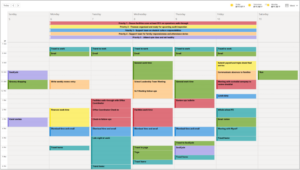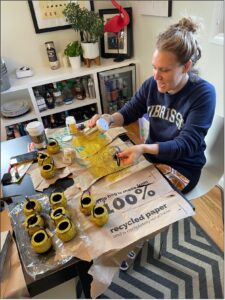Maia’s Note: I met Kristin Barnhart, a Learning Specialist and 5th Grade Team Leader in Nashville, a few years ago at a teacher-leader training, and I was WOW-ed by her Togetherness as a special educator. She is passionate about supporting all students to meet high expectations AND supporting teachers to create systems for student success and long-term sustainability in the classroom. And you all were wow-ed too based on the popularity of my first feature of Kristin. So, I invited her back and this time, you get to hear from Kristin in her own words! Enjoy! MHM

Kristin Barnhart
***
As a special education provider, the majority of my job must be documented in some form to comply with federal law. Over the years, I’ve developed some systems to keep up with the IEP paper train, minimize my time in front of a computer, and maximize my time with my students, not to mention freeing up the weekends to enjoy my life beyond the school walls! In this post, I offer some of my favorite Before, During, and After IEP meeting tips with a focus on preparation, efficiency and batch processing!
Before
– Student Folder – This gives me one place to keep all of the papers I collect before the IEP meeting occurs. It saves me time because I’m not hunting for the same piece of paper five different times.

- Folder Contents
- Meeting Organizer
- Completed Teacher & Parent Observation Forms
- Student Data
- Front of Folder – We give and get paperwork from a variety of individuals, so I note here what forms I’ve given to whom, along with the clear deadline for return. If the paperwork isn’t returned, I know who to remind via email, and when.

– Student Present Levels and Goals – I follow a structure for all present levels and goals that I write. This helps me quickly draft the IEP because I’m following a set pattern. Disclaimer: I am NOT writing the same exact goals for all students, I’m simply giving myself some sentence stems, so I don’t have to start from scratch each time. Here’s how it works:
- Academic Present Level Structure: “Student A recently took the ___________________ assessment. On this assessment she scored a ___________. This score places her in the ___ percentile. This means that if she was compared to 100 peers she would outperform ______ peers. Her current grade equivalent level is _______. She has strengths in _________. She needs to focus improvement on ___________.”
- Academic Goal Structure – Reading Fluency: “Given a ___________ (condition), Student A will be able to _________ (skill) with _______ (accuracy) as measured by ________________ in 3 consecutive weekly probes (time frame).”
During
– Materials Station – I have a one-stop station to gather everything I need for a meeting. When parents come to the office, I go to a cabinet to get extra pens, paper clips, and the Procedural Safeguards. To help the meeting run efficiently, I discuss these with the family as we walk to the meeting.

– Copies for IEP Team – There is a lot of information to share with parents at the meeting. It’s easier to digest and explain if there are copies for parents to look at while you are talking. Our electronic system allows us to print off a draft copy to share with the team. Meanwhile, I keep the IEP website open to make changes to the IEP before we finalize the plan as a team.
After
– Post Prior Written Notice and Filing – Write the Post-Prior Written Notice and file the final IEP right away. I know there’s pressure to return to your students, but you’ll save time by filing while your brain is still in meeting mode.
– Signatures of Teachers Not in Attendance – In Tennessee, we are required to discuss the IEP with all teachers who were unable to attend the meeting. This is documented by signing the IEP. Set a regular time with your team to review new IEPs. For me, this is the day after an IEP meeting, during our morning meeting as a team. I add it to my daily schedule as a visual reminder in my Flexy Friend.

There you have it. None of my approaches are rocket science, but as you can see, a few small steps before, during and after the meeting make everything run a little more smoothly for families, colleagues and ultimately, my students!


